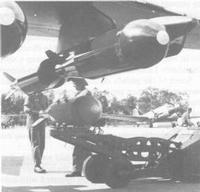


Chapter 13
I Colonial Origins
II First World War
III Between The World Wars
IV The Second World War
V Post-second World War
i The United Kingdom Australia Agreement
ii The ADSS
iii Decline of Imported Work
iv Background Research and Development of the Department of Supply
v Technology in the Armed Services
VI After The Joint Project
VII Science And Decisions At The Top
VIII Armed Services Technology
IX New Tasks And Projects
X Transfer Of Research And Development
XI Acknowledgement
References
Index
Search
Help
Contact us

The work was applied to civil and service aircraft. Later full scale tests were to be made to large components of in-service aircraft, such as Mirage III-O wings, and modifications to structures were to be made as a result of the analyses. On the way, the work generated such innovative practices as in-flight strain recorders and, much later, "band-aid" repair of aircraft structural items by the application of fibre-resin plastic patches specifically designed to meet the local stress conditions. As experience was gained it was possible to revise earlier estimates of life and indeed in the case of the Mirage, it was possible to extend safely the usable life beyond the manufacturer's estimates. The cost saving was considerable.
The greatest challenge in this work came in 1968, with the failure of the Flll-C within hours of official 'acceptance' by the Australian government. Working closely with the United States Airforce and the manufacturers, General Dynamics, ARL was able to make a major contribution to the analysis and solution of the problem. As a result of its work, the design of several components was changed and the machining practice was radically modified. During the work fundamental contributions to the theory of aircraft structures, corrosion fatigue, crack propagation and the statistics of failure were made.[56]
Bomb Aerodynamics
The Aerodynamic Division of WRE had conducted research in aerodynamics using wind tunnels and free flight models. This was to be applied to operational procedures and to weapon development.
Instability in the flight of bombs immediately after release from aircraft had long been known as a major source of bombing inaccuracy. It became of greater significance as bomber speeds increased, and was recognised as a hazard to the aircraft as very low level bombing became a common tactic.
Theoretical and experimental studies resolved the basic instability factors which were due to the dynamic coupling of rolling or spinning with natural pitching or yawing motions which caused 'coning' action, with high drag consequences. Mathematical modelling techniques developed for guided weapon operational analysis, were now applied to bombs which could be instrumented to validate the models.
The United States Air Force had developed a retarded bomb (called Snakeye) to permit very low sorties without aircraft damage. Modifications were made to the retarding mechanism in the Australian project called BALLARA. These modifications were adopted by the RAAF and the USAF.
The European and Asian theatres had generated staff requirements for dispersal weapons to be used against 'soft-skinned' targets like aircraft and light buildings. (Conventional bombs produce an excessive amount of damage, overkill, in a very small area.) The concept now was to launch a canister of a very large number of quite small bomblets, and to disperse these in a predictable pattern.[57]
With remarkable ingenuity, the work of WRE in clarifying the cause of bomb instability was put to use in securing a stable bomblet attitude in flight so as to produce a continuous lift force to cause divergence from a general heading. This was achieved by a careful arrangement of bluff body shape, centre of gravity and fin configuration. A family of sub-munitions could thus be made to scatter over a considerable area. This aerodynamic solution was an Australian contribution to a collaborative investigation on bomblet scattering with the USA and the UK. It was utilised in the development of a weapon to meet a RAAF staff requirement. The project was known as KARINGA.

Organisations in Australian Science at Work - Aeronautical Research Laboratories; Australia. Department of Supply; Weapons Research Establishment (W.R.E.)
 |
Australian Academy of Technological Sciences and Engineering |  |
© 1988 Print Edition pages 951 - 952, Online Edition 2000
Published by Australian Science and Technology Heritage Centre, using the Web Academic Resource Publisher
http://www.austehc.unimelb.edu.au/tia/930.html